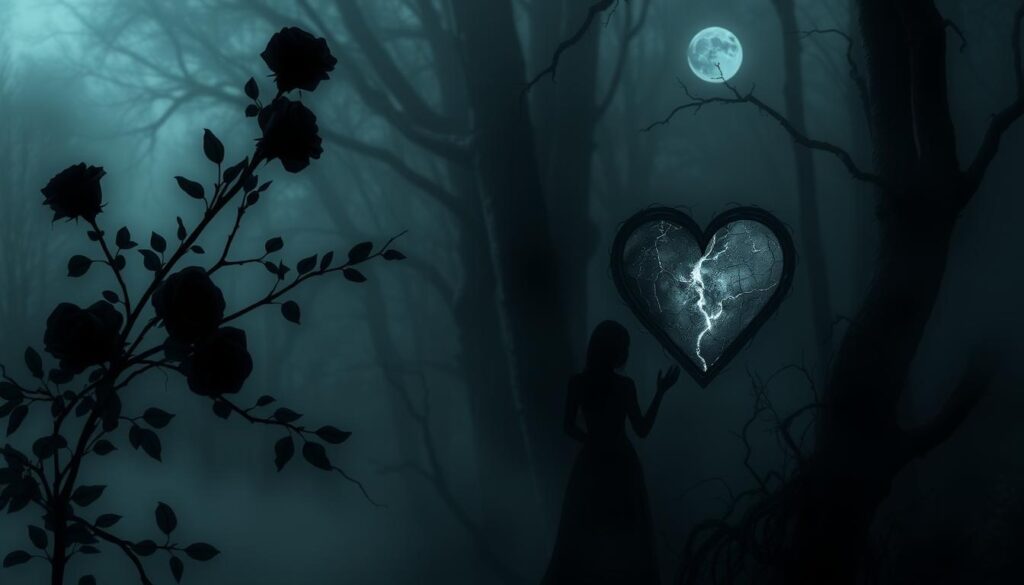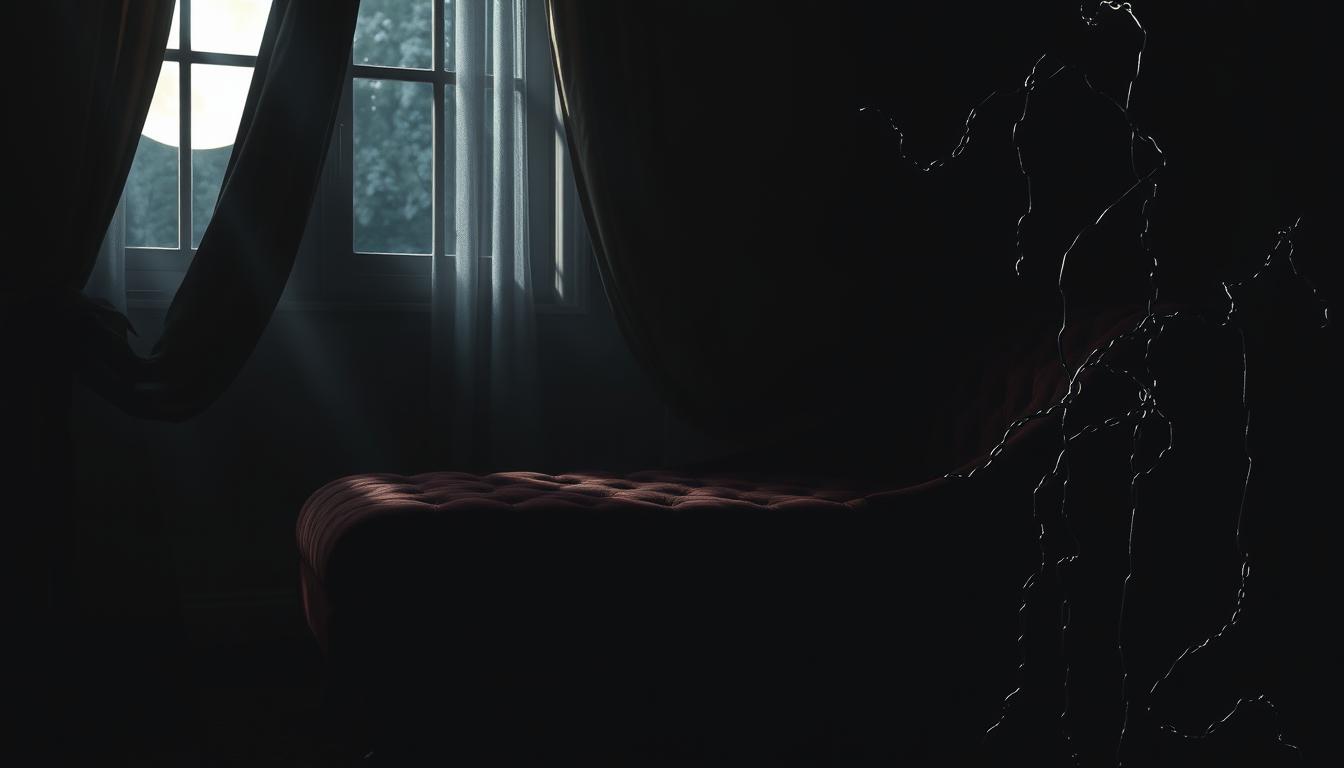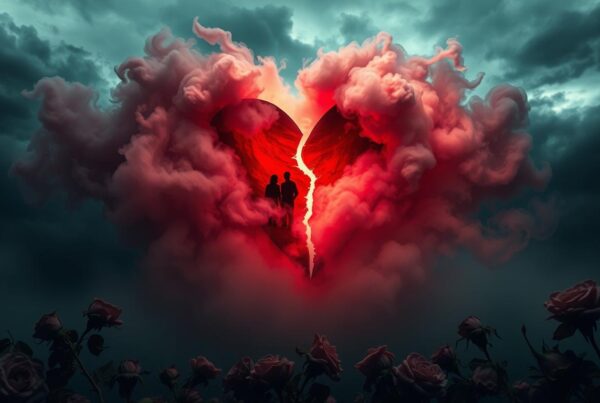Step into the shadows of psychological romance. Here, forbidden passions ignite and dark desires reign supreme. This genre explores the hidden corners of the human psyche. It delves into the irresistible pull of taboo relationships.
In literature, the allure of the forbidden has long held readers spellbound. Psychological romance takes this fascination to new depths. It unravels the complex emotions and motivations behind our most secret longings.
Join us as we embark on a journey through the tantalizing landscape of dark desires. We’ll uncover the psychological roots of forbidden attraction. We’ll examine the impact of societal norms and explore the narrative techniques that bring these stories to life.
Unveiling the Shadows: Understanding Psychological Romance
The psychological romance genre mixes deep emotions with insights into the mind. It offers a thrilling read that looks into the human soul and love.
Where Psychology Meets Passion
Psychological romance novels dive into characters’ minds. They show more than just attraction. They explore what drives people in love.
These stories often show characters facing their own mental battles. They do this while dealing with deep love.
The Allure of Forbidden Love
Forbidden love is key in many of these stories. It brings excitement and conflict. This forbidden aspect helps characters grow and learn.
Dark Desire Drivers
The dark desires in these novels are complex. Characters might be drawn to the wrong partners. This could be due to past hurts or a need for love.
These drivers add tension and keep readers hooked. They make the story exciting and full of conflict.
The Psychology Behind Forbidden Attraction
Forbidden love is fascinating. It shows how taboo relationships can make our desire stronger. This is called the Romeo and Juliet effect. It says that when we’re not allowed to be together, our love grows.
Reactance theory helps us understand why we might want what we can’t have. When we’re told we can’t choose a partner, we might feel a strong urge to do so. This makes forbidden love even more tempting.
Neuroscience sheds light on why we’re drawn to forbidden love. Our brain’s reward system releases dopamine when we take risks. This makes us feel good and want more of that feeling.
Culture and society also play a big part. What’s seen as taboo changes over time and place. This makes the psychology of attraction even more complex. The allure of forbidden love changes with the times.
Historical Context: Taboo Love Through the Ages
Love stories have captured hearts for centuries. They show how romance has changed over time. From ancient myths to today’s stories, they reflect the changing views on love.
Ancient Tales of Forbidden Romance
The story of Pyramus and Thisbe comes from ancient Babylon. It tells of two lovers from feuding families. This idea of star-crossed lovers has inspired many, like Shakespeare’s Romeo and Juliet.
Evolving Societal Norms and Romance
Societies have changed, and so have our views on love. In the past, some loves were forbidden. Now, we celebrate these stories, showing how acceptance and rights have grown.
Modern Twists on Classic Love Stories
Today’s authors give old love stories a new spin. They set them in modern times and with today’s views. These updates keep the timeless charm of love alive, reaching new readers.
Crafting Complex Characters: The Antihero and the Temptress
In psychological romance, antihero characters are very important. They are flawed and have inner struggles. Unlike heroes, they have dark traits that make them both attractive and risky.

The temptress archetype is also key in dark romance. She represents forbidden desires and challenges what society expects. Writers give these characters deep backstories to show their true selves.
Creating believable antiheroes and temptresses is all about depth. Authors look into their pasts, showing what makes them tick. This makes readers understand and even root for characters who make tough choices.
To make antiheroes stand out, writers mix good traits with bad. A detective might break rules to solve crimes. A charming thief might steal to feed his family. These mix-ups make characters interesting and hard to guess.
Temptresses in psychological romance are more than just pretty faces. They might use their charm to protect themselves or gain power. By exploring their fears and dreams, authors turn stereotypes into real people that readers can connect with.
Dark Desires: The Allure of Forbidden Passions in Psychological Romance
Forbidden passion draws us into psychological romance novels. This genre dives deep into human desire. It explores taboo relationships that society finds wrong.
The thrill of the forbidden is hard to resist. It taps into our deepest fantasies.
Exploring the magnetism of the forbidden
Forbidden love is incredibly attractive. The excitement of breaking rules and defying norms fuels their passion. This attraction often comes from society’s rules or personal morals.
The role of secrecy in intensifying desire
Secrecy makes forbidden romances even more intense. The need to keep their feelings hidden adds to their closeness. This secrecy brings a mix of excitement and fear of being found out.
Psychological factors that fuel forbidden passions
Several factors make forbidden love so appealing. The thrill of taking risks, the urge to rebel, and the need for approval are key. These elements mix to create a strong emotional pull that keeps readers eager for more.
The Fine Line Between Love and Obsession
Love and obsession mix in dark romance stories. Authors carefully show deep feelings while looking at psychological limits. The charm of these tales comes from mixing deep love with unhealthy attachments.
In psychological romance, characters face strong emotions. Their love can turn into a strong fixation, crossing normal limits. Writers show how love can turn dark, making us both drawn and uneasy.
Obsessive love makes us think about healthy relationships. It makes us question our views on love and attachment. Authors show us the complex side of love, making us think about where love stops and obsession starts.
Dark romance novels reflect our deepest desires and fears. They let us explore forbidden love safely. Through these stories, we learn about the thin line between love and obsession, gaining insight into our minds.
Narrative Techniques in Psychological Romance
Psychological romance novels grab readers with their deep emotions and complex relationships. Writers use many techniques to make stories that dive into human desire.
Building tension through internal conflict
Internal conflict makes characters’ actions interesting and keeps readers hooked. Characters face a battle between their desires and duties. This struggle builds tension, making the story more exciting.
Writers share characters’ thoughts and feelings. This lets readers see their inner fights. It’s like being right there with them.
Unreliable narrators and their effect on the story
Unreliable narrators bring mystery and intrigue to these romances. They might not tell the whole truth or see things differently. Readers have to figure out what’s real, making it fun and interactive.
This method keeps readers guessing. It also adds depth to the story.
The power of subtext in romantic encounters
Romantic subtext adds meaning to how characters talk and act. Writers use small signs, body language, and feelings that aren’t said out loud. This makes the romance more intense and memorable.
It leaves a strong impression on readers. They feel like they’re part of the story.
Symbolism and Metaphor in Dark Romance
Dark romance writers add depth with literary symbolism. They show forbidden love through images. Roses with thorns mean beauty and pain in dangerous love.

Romantic metaphors are key in these stories. Authors might say love is like a raging fire. It’s both beautiful and dangerous. The push and pull between lovers is like the tide, always moving.
Dark romance themes are brought to life by symbols. Blood can mean desire and danger. Shadows are the unknown parts of a lover or secrets in a forbidden relationship. Night means freedom from rules, when lovers can meet in secret.
Writers use symbols and metaphors to create deep stories. They speak to our deepest desires. By using these tools, they invite readers to find hidden meanings and feel the power of dark romance.
The Role of Setting in Creating a Sensual Atmosphere
Setting is key in romance stories, setting the mood and deepening feelings. Whether it’s a gothic castle or a busy city, each place adds its own special touch.
Gothic Elements and Their Psychological Impact
Gothic settings bring mystery and a hint of danger. Think crumbling castles and misty moors. These places make secrets and danger feel real.
They also make the love between characters more intense. It’s like the setting is alive, adding to the excitement.
Urban Landscapes as Backdrops for Forbidden Encounters
Urban settings give forbidden love a modern twist. Cities with their secret alleys and dim bars are perfect for secret meetings. Here, characters can explore their desires without being seen.
Exotic Locations and Their Role in Intensifying Passions
Exotic places take readers on a journey, making forbidden love even more exciting. Imagine sun-kissed beaches or ancient ruins. These places let characters forget their worries and follow their hearts.
Exploring Taboo Themes in Modern Psychological Romance
Modern psychological romance explores themes that challenge our norms. Writers tackle topics that show the complexity of love today. They push the limits of what we think is acceptable.
Age gaps in love stories are now common. These tales look at power and the shame around big age differences. They show how these relationships can lead to personal growth.
Stories about love in the workplace are also popular. They deal with the ethics of boss-employee or teacher-student romances. These stories make us think about the feelings and choices people face.
Non-traditional relationships are also being explored. This includes polyamory, open marriages, and more. These stories make us think differently about love and commitment.
By discussing these topics, authors entertain and start important talks. They help us see the world in new ways. The themes in psychological romance keep changing, showing our evolving views on love.
The Impact of Cultural Norms on Forbidden Desires
Cultural norms shape how we see love and desire. These norms change from society to society. They decide what’s okay and what’s not in relationships.
These norms deeply affect forbidden desires. They often block people who want love outside what’s expected.
Cross-cultural romances and their challenges
Relationships across cultures have big challenges. Language, values, and family expectations can be tough. But, many couples find their differences make their bond stronger.
Societal pressures and their influence on romantic choices
Societal pressure on love is strong. It makes people follow norms, even if it’s not happy. This pressure comes from family, religion, or culture.
Many face hard choices between what they want and what society expects. This leads to inner conflict.
Breaking barriers: Challenging cultural taboos through literature
Literature is key in breaking taboos and broadening our love views. Books that delve into forbidden desires let us safely explore our thoughts. They show different kinds of love and challenge our norms.
Psychological Archetypes in Dark Romance
Dark romance novels explore deep psychological archetypes. They create characters that connect with readers on a basic level. These archetypes are key in making stories and characters interesting.
The shadow archetype shows the hidden, darker parts of a character. It adds mystery and depth to their actions and reasons.
Characters like the brooding antihero or the mysterious femme fatale come from these archetypes. The anima and animus, the feminine and masculine sides of us, are important in love stories. They explain why characters are drawn to each other, even if they don’t want to be.
Archetypes like the trickster add complexity to dark romance stories. This figure is a charming troublemaker or a manipulative seductress. They shake things up and challenge the usual ways of thinking. By using these archetypes, authors make dark romance novels both exciting and thought-provoking.



